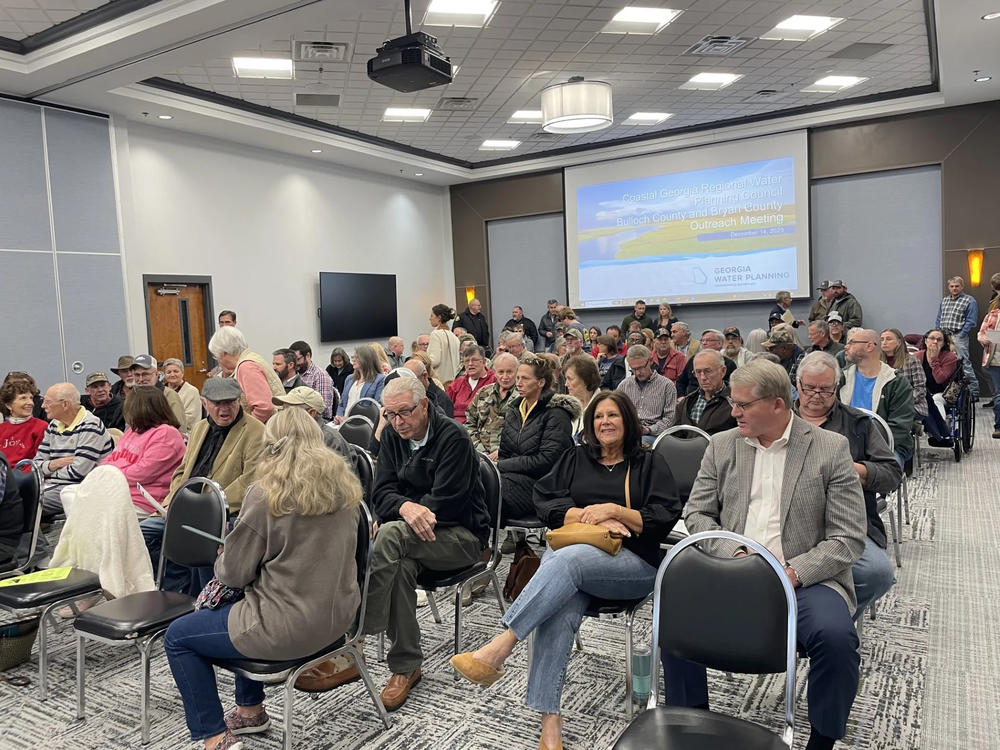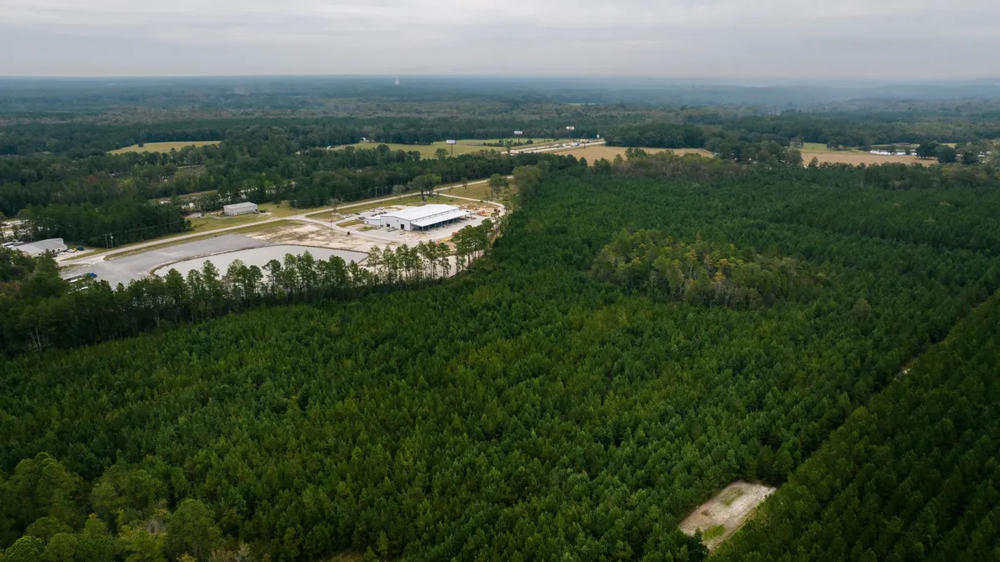
Caption
Residents await the start of a packed public meeting in Statesboro, Ga., on Thursday, Dec. 14, 2023, about plans to drill four new drinking water wells to supply the new Hyundai plant.
Credit: Mary Landers/The Current

Residents await the start of a packed public meeting in Statesboro, Ga., on Thursday, Dec. 14, 2023, about plans to drill four new drinking water wells to supply the new Hyundai plant.
Mary Landers, The Current
STATESBORO — Plans to drill four new drinking water wells in Bulloch County to supply almost 7 million gallons a day of water to serve the Hyundai Metaplant and associated development in Bryan County drew concern and criticism at a packed public meeting in Statesboro Thursday.
“We’re concerned about our water table, our wells going dry,” said Bruce Simons. “We’re concerned about the wetlands in that area. … Please, we need to look at strictly surface water for that plant.”
The Coastal Georgia Regional Water Council met at Ogeechee Technical College with more than 120 residents in attendance. Representatives from the Georgia Environmental Protection Division as well as engineering consultants to Bulloch and Bryan counties provided updates for the two counties.
Bryan is looking to its neighbor Bulloch for water in part because there’s more water available there. Water withdrawals from the Floridan aquifer are limited in Bryan and even moreso in Chatham and part of Effingham under a state mandate to manage saltwater intrusion in the aquifer, which covers 100,000 square miles of the southeastern United States including all of Florida, the coastal plain of Georgia and into South Carolina.

One of four proposed Bulloch County well sites to provide water for the Hyundai Metaplant.
“As early as 1960s, we started to see saltwater intrusion in Hilton Head Island,” Shayne Wood of consultant CDM Smith explained. “And in the ’80s and ’90s is when they really started looking at it together between the two states. A lot of it had to do with the pumping that was going on in the Savannah area associated with industries and of course, public supply.”
The Coastal Georgia Regional Water Planning Council is one of 11 regional water planning councils created in 2008. Appointed by the governor, the lieutenant Governor and the speaker of the house, the 29-member group released its most recent water plan in June.
Of the four planned wells in Bulloch, two will be owned by Bulloch and two by Bryan County. “Bulloch County will wholesale water from these wells to Bryan County for the purpose of serving the Bryan County Mega-Site (sic) and the North Bryan County region,” Bulloch’s consultant wrote in its permit application.
Bryan County is already constructing a well at the Hyundai site, but it and another new well nearby are being built within the county’s existing “yellow zone” limits.
Surface water is part of the planning, but not for the short term term, said Trent Thompson of Thomas & Hutton Engineering.
“Long term, I think everybody realizes that surface water is going to be ultimately what we need to figure out how to take care of,” he said.
Working with City of Savannah, consultants are developing 25-year plan with “massive financial implications” to increase the capacity of the city’s surface water treatment plant and pipe that water out to Effingham and Bryan counties, Thompson said.
Although the planned wells have been pushed slightly further into Bulloch County and farther apart than originally situated, Bulloch residents are still concerned about the impact on existing residential and agricultural wells. Bulloch has about 197,000 acres of farmland, about 17,000 of which is irrigated, according to the US Department of Agriculture.

The map shows the proposed locations of two wells along Ga. Highway 46 in Bulloch.
“How many privately owned wells are going to be affected by this to the point where those people are going to be collateral damage?” asked Tracey McMillan. “They’re not gonna be be able to sell the property, not be able to live on it. What’s going to happen to it? That sort of thing needs to be included in this impact studies. And that kind of stuff needs to be done well before you make a decision on whether or not to approve these permits, and the community needs to be fully informed and involved in that whole process before any decision is ever made on the approval of those permits.”
And they’re concerned about how close to the yellow zone the wells will be.
“My understanding of the reason Bryan County was placed in the yellow zone to start with was to minimize the threat of saltwater intrusion,” Tim Powell said. “Does anyone on this council think that saltwater knows where the Bulloch County/ Bryan County line is?”
His statement drew applause.
With a show of hands more than an hour into the meeting, nearly everyone in the standing-room only hall agreed with the comments of their neighbors.
Barbara Reid, a retired hospital administrator, lives on a 27-acre property that’s already had water issues. She had to dig her well deeper three years ago. She’s worried that the planned wells will leave her and especially her farming neighbors without enough water.
“The county commissioners want to grow the county — great, ” she said. “Then don’t throw away the people that are the foundation and the pure core of this county.”
While no elected officials accepted an invitation to speak ahead of the public comments, at least two elected officials attended the meeting: Bulloch County Commissioners Timmy Rushing and Toby Conner, the latter speaking during the public comment period without indicating his position.
Ben Kirsch, legal director with the Ogeechee Riverkeeper, made a plea for better planning.
“Because without comprehensive planning, you get haphazard wells, you get four wells lined up right along with the green/yellow line where you know, that arbitrary county line isn’t really reflective of what’s going on with the aquifer,” he said. “We’re relying on a 2006 plan to kind of make a lot of these decisions and we really need to re-assess what is happening in the aquifer. We need to communicate this with the impacted communities so that we’re not blindsided by these decisions.”
He called for planners to prioritize drinking water and agricultural water over industrial water, which doesn’t need to be treated to the same standard.
“The upper Floridan aquifer supports our whole region and that water is pristine, and we kind of undervalue it,” Kirsch said.
Jen Hilburn of the nonprofit One Hundred Miles said her group had been studying the situation with the aquifer and surface water.
“It’s time to live within our means,” she said. “It’s time for our counties and municipalities, sure we can share a little bit, but it’s time for us to stop going farther inland, farther upriver,” she said. “Just not to keep using more and more communities’ resources to fuel industrial growth.”
The EPD’s review of the permit applications for the wells should take about three to six months, said Wei Zeng, a hydrologist who manages EPD’s water supply program. When a draft permit is produced the public will again be able to comment on it. At Thursday’s meeting, the public was allowed to comment, but officials did not respond or answer questions.

One of four proposed Bulloch County well sites to provide water for the Hyundai Metaplant.
Tony Rojas of TPM Consulting is working with Bulloch on water issues. Water needs aren’t only related to Hyundai, he said.
“One thing that I would point out to you is that Bulloch County is a growing county irrespective of what is happening with the Hyundai development and that growth,” he said.
Bulloch increased by 11,000 residents from 2010 to 2020, long before the EV plant was announced. The 2022 population was about 83,000, according to the U.S. Census. With Hyundai fueling that growth further, the population is expected to increase by 34,000 over the next quarter century, Rojas said.
He estimates the county will need an additional 3 million gallons per day of drinking water over the next 25 years.
David Bennett, a nurse and military veteran who is running for county commission chair in the May Republican primary in part because of water issues, is frustrated by the plans he heard.
“This whole process is backwards,” he said. “Yep. Before we start talking about where we’re gonna put a well, why haven’t we put a test well out there to see we can even handle the capacity that you’re talking about?”
Residents said the meeting came too late and they felt left out of the planning.
“I think this is a done deal,” said Charles Moore, an 80-year old retired postmaster from Evans County. “Y’all had to have this meeting because it’s required by law. Y’all have ignored us.”
This story comes to GPB through a reporting partnership with The Current.